This post may contain affiliate links. Please see my disclosure policy for details.
If you have more than one day in Sintra, then I highly recommend adding the magical Monserrate Palace & Park to your itinerary.
The entire estate looks like it has been plucked from the pages of a fairytale and is filled with Romantic, Gothic and Moorish influences.
It was developed by British trader Sir Francis Cook, the 1st Viscount of Monserrate and it also has links to English novelists and poets such as Lord Byron and William Beckford – so it’s a little bit of England in Portugal!
This ended up being one of my favourite places I visited in Sintra as it was much quieter than the other crowded sites like Pena Palace and Quinta da Regaleira. It’s a bit of a hidden gem in Sintra Hills.
Here is why you shouldn’t skip the Park and Palace of Monserrate in Sintra and why it’s worth it!

Top Sintra Travel Resources
- Book your perfect hotel stay at Booking.com
- Buy a Lisbon Card for free transport to Sintra and book your Pena Palace ticket before you go!
- Book your tours and attraction tickets with GetYourGuide
- Thinking of renting a car? Look up Rental Cars
- Don’t forget travel insurance, I always use World Nomads
Monserrate Palace history
Although the Park and Palace of Monserrate we see today was an invention of Sir Francis Cook in the 19th century, the history of this estate starts in 1540.
At that point, it was home to the Chapel of Our Lady of Monserrate which was inspired by Monserrate Monastery near Barcelona in Spain.
The Mello e Castro family then held rights to the land but the 1755 Lisbon earthquake devastated the entire estate.
It was rebuilt by Gerard of Visme who was a British trader and he ordered for a Neo-Gothic palace to be built.
William Beckford, a British novelist then bought the estate and started making renovations only to move out a few years later.
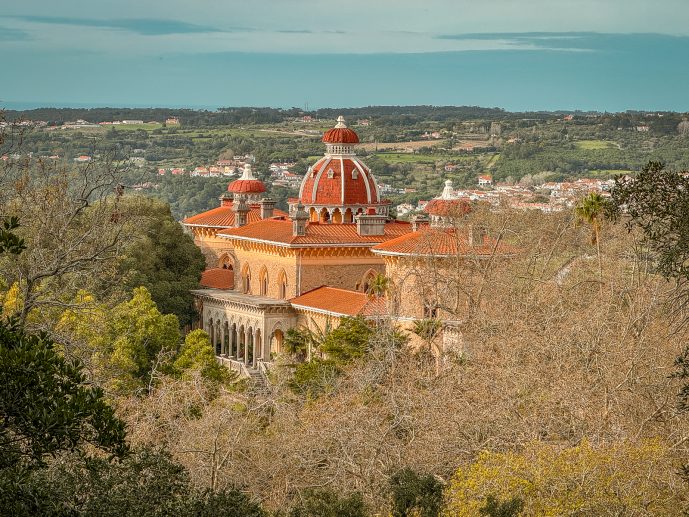
Sintra became a popular muse for British writers and artists in the 18th and 19th centuries with Lord Byron calling it “Glorious Eden”.
Byron mentions Monserrate Palace in his poem “Childe Harold’s Pilgrimage” and this, in turn, inspired Sir Francis Cook to visit.
Cook was a British trader who served in India and he fell in love with this estate in Sintra. So, he decided to buy it and then he became the 1st Viscount of Monserrate.
He then created his dream palace with Romantic, Moorish, Arabesque, Indian and Gothic influences and a vast parkland with plants, shrubs and trees from across the globe.
The Cook family lived here for several generations and used this property as a summer house and for entertaining guests.
It was eventually abandoned and fell into ruin until it was purchased by the Portuguese government in 1949.
Monserrate Palace was classed as a Property in the Public Interest and later became absorbed into the Sintra Hills UNESCO World Heritage Site in 1995. Today, it’s managed by Parques de Sintra.
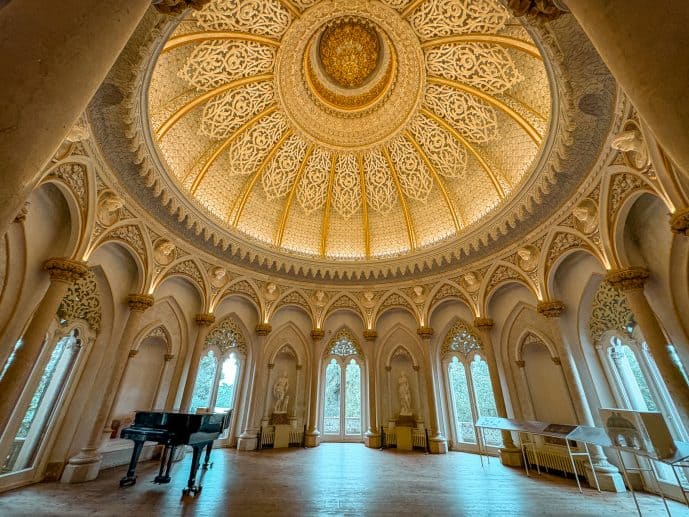
Why you shouldn’t skip Monserrate Palace in Sintra
As Monserrate Palace is a little further away from the more popular attractions in Sintra Hills, most visitors tend to skip this gorgeous estate.
But, I would personally prioritise this park as fewer crowds make this a bit of an oasis to escape the chaos.
Despite the distance from Sintra Historic Centre, it’s still easy to get here by public transport or taxi if you’re not driving.
There are also plenty of things to do here that make it worth visiting.
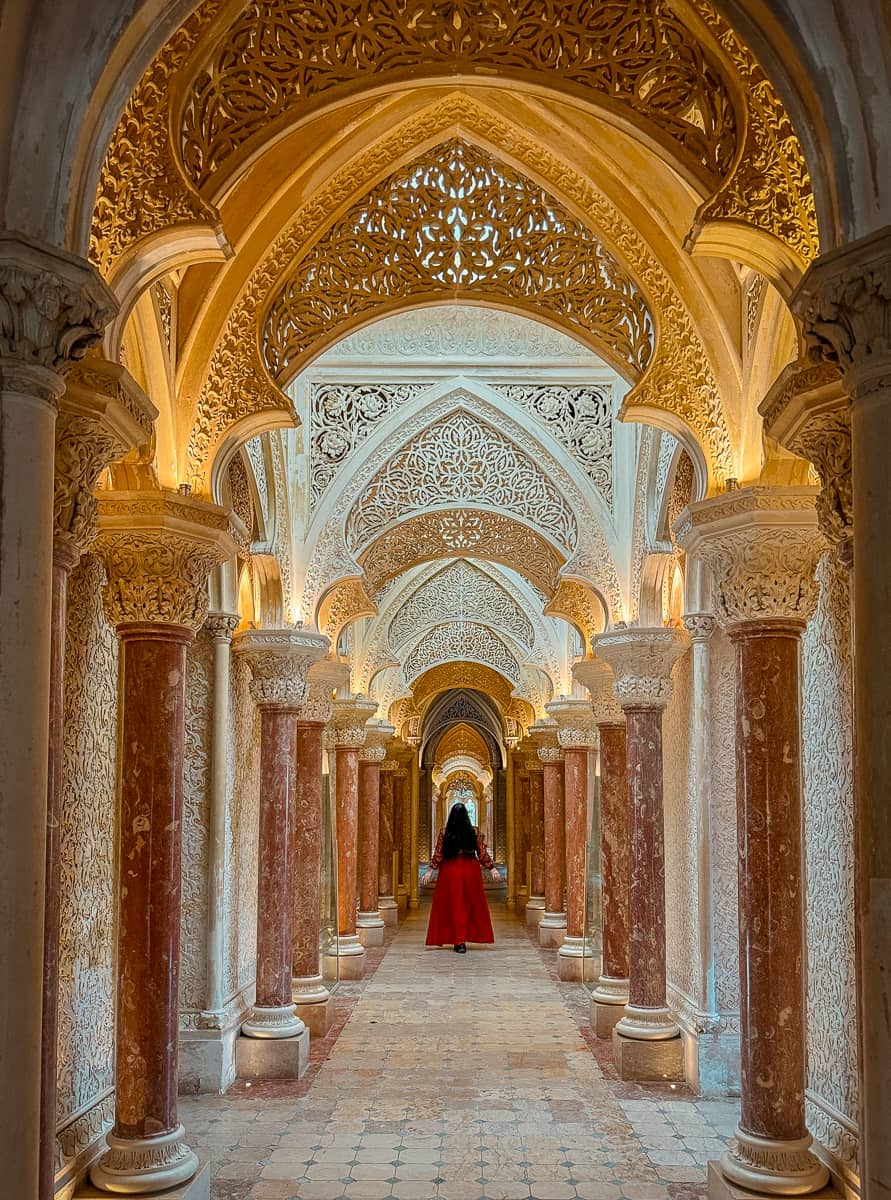
Things to see in Monserrate Palace
The Park and Palace of Monserrate is a huge estate so I recommend leaving at least 2-3 hours to everything at a relaxed pace.
As well as the Arabesque Palace, there are planned English gardens, chapel ruins, a tea room, a gift shop and an extensive parkland to explore.
Here are all the things to do at the Park and Palace of Monserrate;
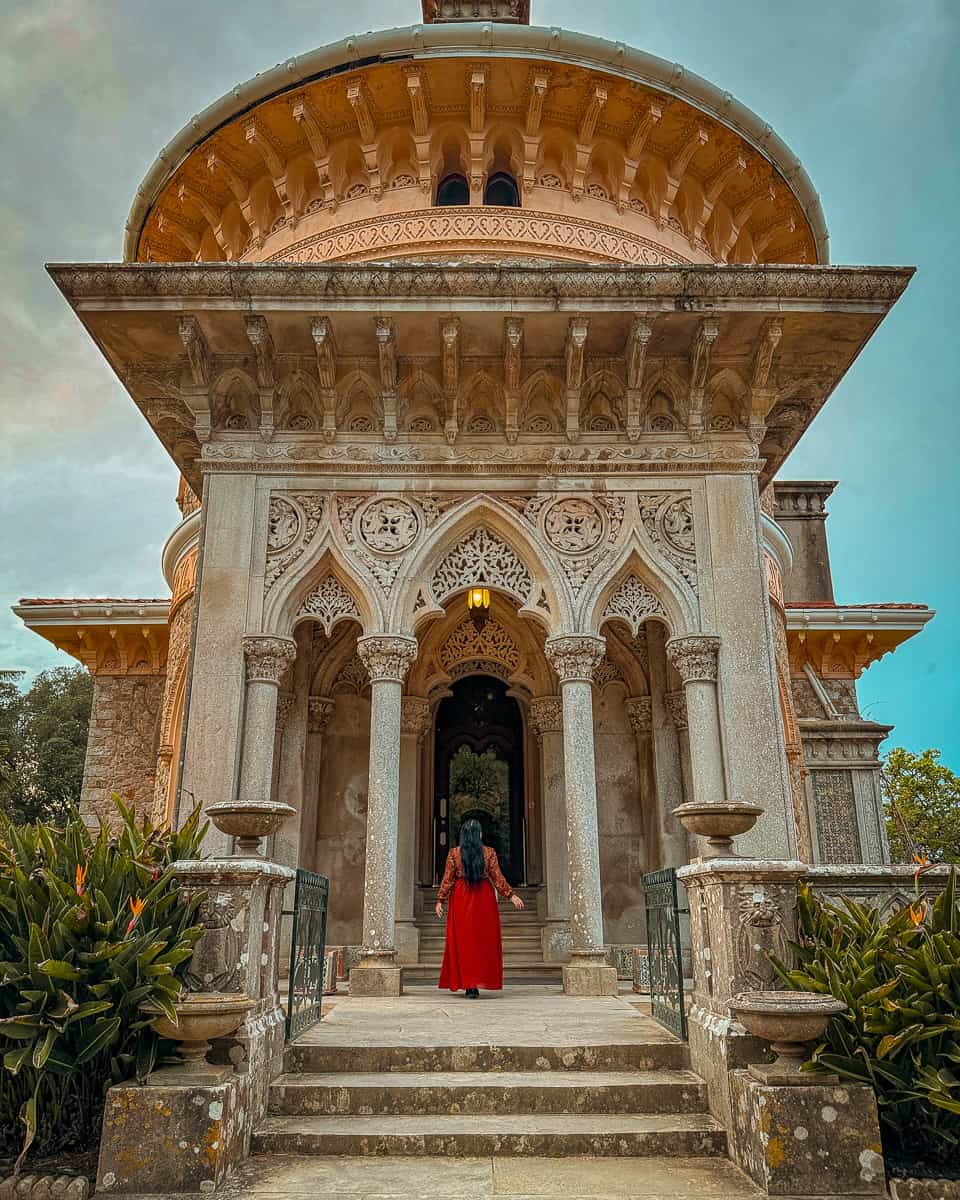
Beckford’s Waterfall & Vathek’s arch
It will take you around 15 minutes to walk to the palace area from the entrance of the park if you make a beeline.
But, there’s no right or wrong way to explore. You can visit the palace first or explore the park and finish at the palace.
As I visited near closing time I decided to go straight to the palace to make sure I didn’t miss the last entry time.
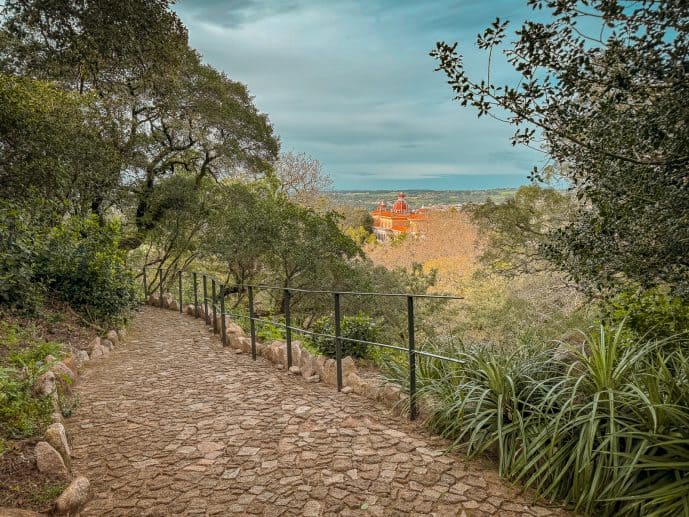
The walk is mostly downhill but you will hardly notice as the lush grounds are like a fairytale with incredible birds-eye views of the palace in the distance.
On your stroll, you’ll pass by Vathek’s arch and then Beckford’s Waterfall where you have to cross several stepping stones. There is a barrier to hold onto.
Both the monument and cascade were built to honour the English novelist William Beckford. Vathek is the title of his 1782 Gothic novel.
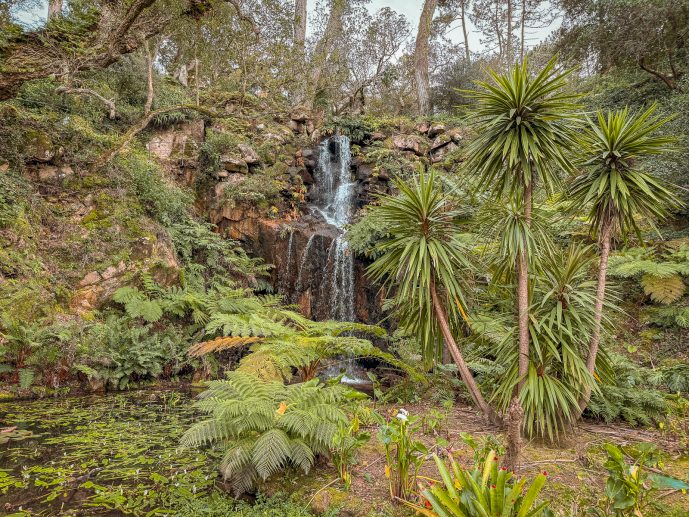
Indian Arch, Terrace and Water Canal
Once you reach the palace area, you’ll pass by the rust-orange Indian Archway that leads you towards a crimson tea room.
This was acquired by Sir Francis Cook during the Indian Rebellion of 1857 in Delhi. I used to live in Delhi once upon a time and I loved all the Indian references on this estate.
Cook bought it from Charles Canning who was the Governor-General of India during the British Raj.
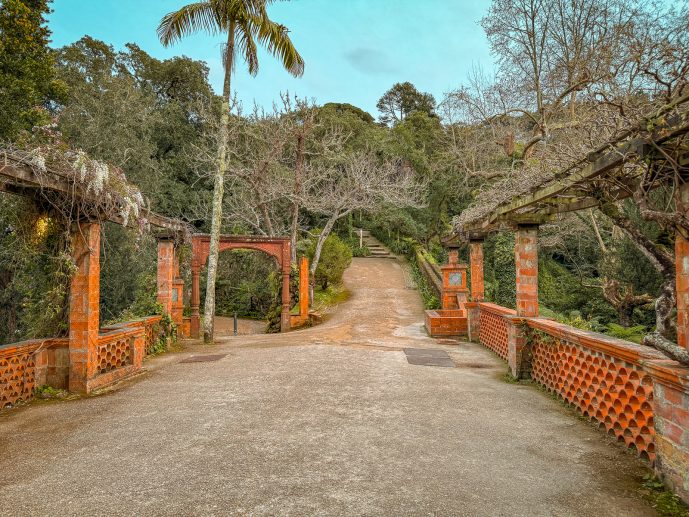
Around the Indian Arch, you’ll find a gorgeous panoramic terrace with decorative tiles. It looks like it would have beautiful blossoms growing on the pergola-style terraces in spring.
If you head down the ornate steps from this terrace, you’ll also find a fountain water canal with a grotto theme.
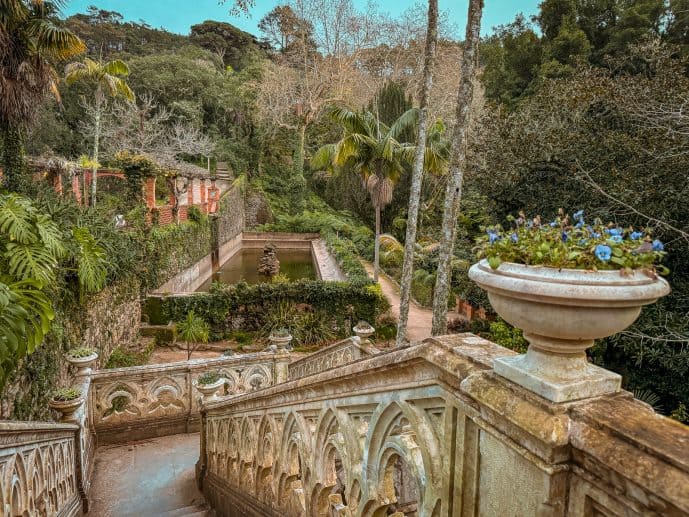
Japanese Garden & Palace Facade
The circular palace facade of the Southern Tower is most impressive with its arched terrace and ornate carving work.
It’s surrounded by a glorious Japanese Garden and in the centre you will find the Triton fountain.
The garden has several statues, lanterns, Bamboo and Camellias to set an exotic ambience and was designed to make a grand impression on visitors. It certainly does that!
On a sunny day, this scene is stunning and makes a fabulous photo opportunity.
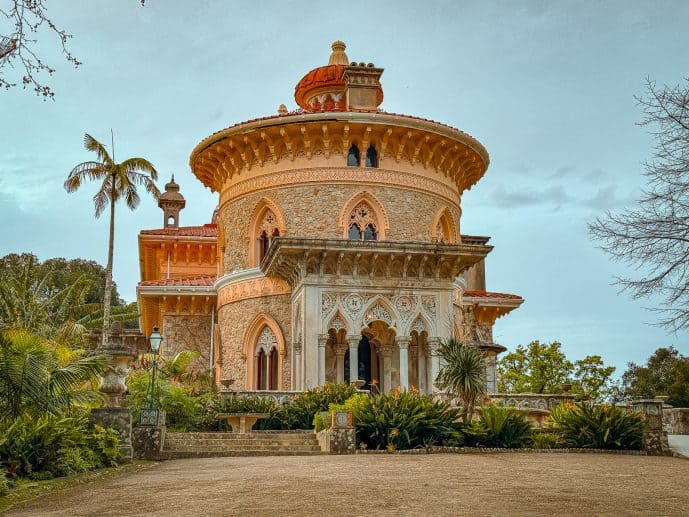
Main Hall
You will start your tour of the palace in the Octagonal central atrium which surrounds a beautiful babbling fountain.
This hall is an existing feature of the original palace built by Gerard of Visme who designed it in a Gothic revival style. These ornate features were inspired by the Portuguese Monastery of Batalha.
As it’s located in the centre of the palace, the family would pass through this atrium regularly and all of the bedrooms on the upper floor surround it.
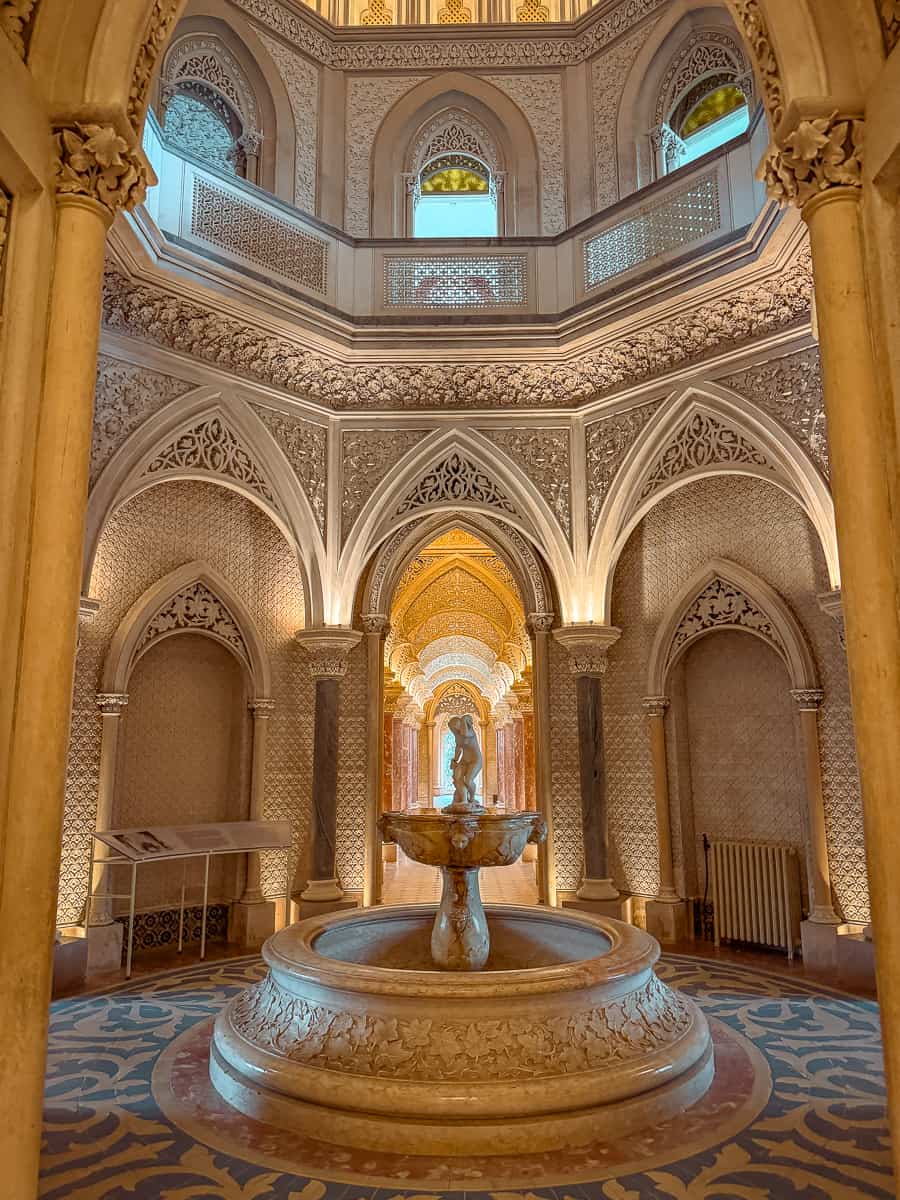
Monserrate Palace Gallery
I have to admit that the thing that drew me to Monserrate was this incredible Moorish gallery built in rose marble and patterned plaster.
As you wander around the many rooms, you’ll meander down this ornate corridor several times and it’s filled with archways and marble reliefs.
It mostly served the practical purpose of getting around the summer palace and providing quick access to the gardens.
But, it also served as a way to impress visitors with its decorative ivory ‘lace’ arches. On the motifs, you’ll find outdoor elements like leaves, stems, blossoms and birds.
These make an excellent photo opportunity! They were just so stunning. But, you may have to be a little patient for an empty photo as these corridors become quite congested.
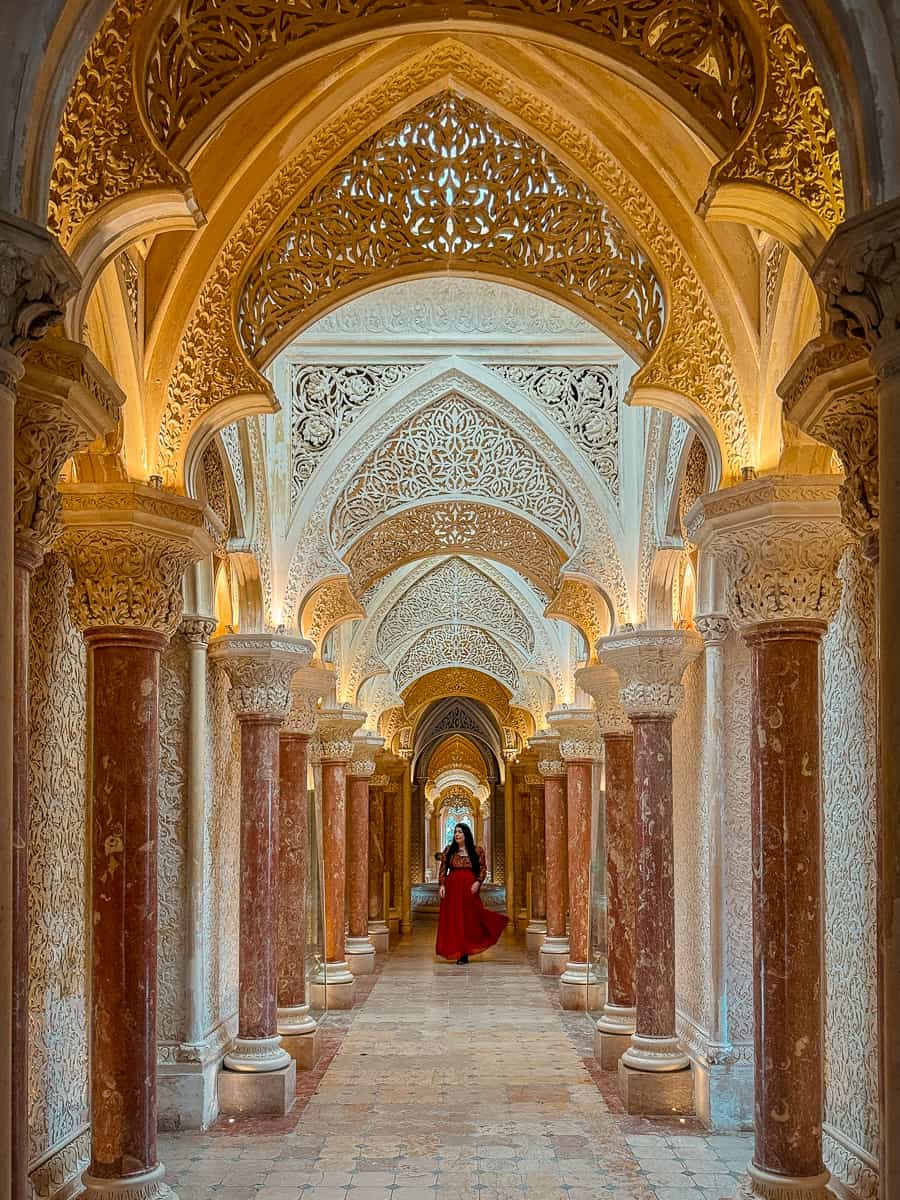
Library
Would it be a grand mansion without a library? This room was used as Sir Francis Cook’s office.
It’s one of the only rooms that closes with a door and you’ll see that the door is carved with a theme of Diana, the Goddess of Hunting.
Although there isn’t a desk these days, they still have dark wood bookshelves filled with classic books. You can also see portraits of Sir Francis Cook and his wife Emily Martha Lucas.
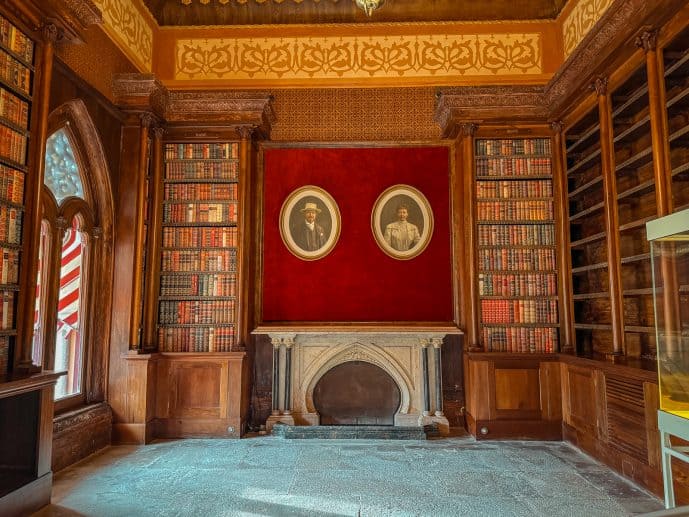
Music Room
The elaborate Music Room dominates the North Tower and is the most impressive room of the house.
This would be where the family would entertain guests for social gatherings and music would be played so the ceiling was arched for better acoustics.
The cupola has a gorgeous intricate decoration which looks like petals and is adorned with gold.
You’ll find busts of Apollo and Saint Cecilia, the patron saint of music plus some symbolic muses.
I can’t imagine how amazing it would have been to enjoy a musical performance here. They do still run them on special occasions as it’s a wedding venue.
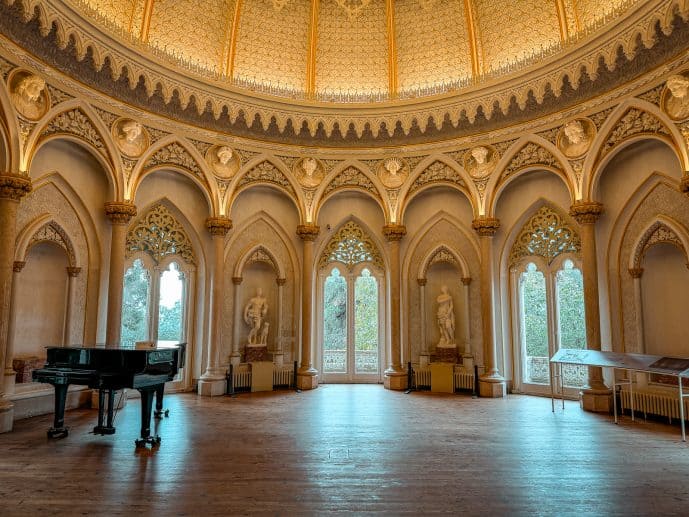
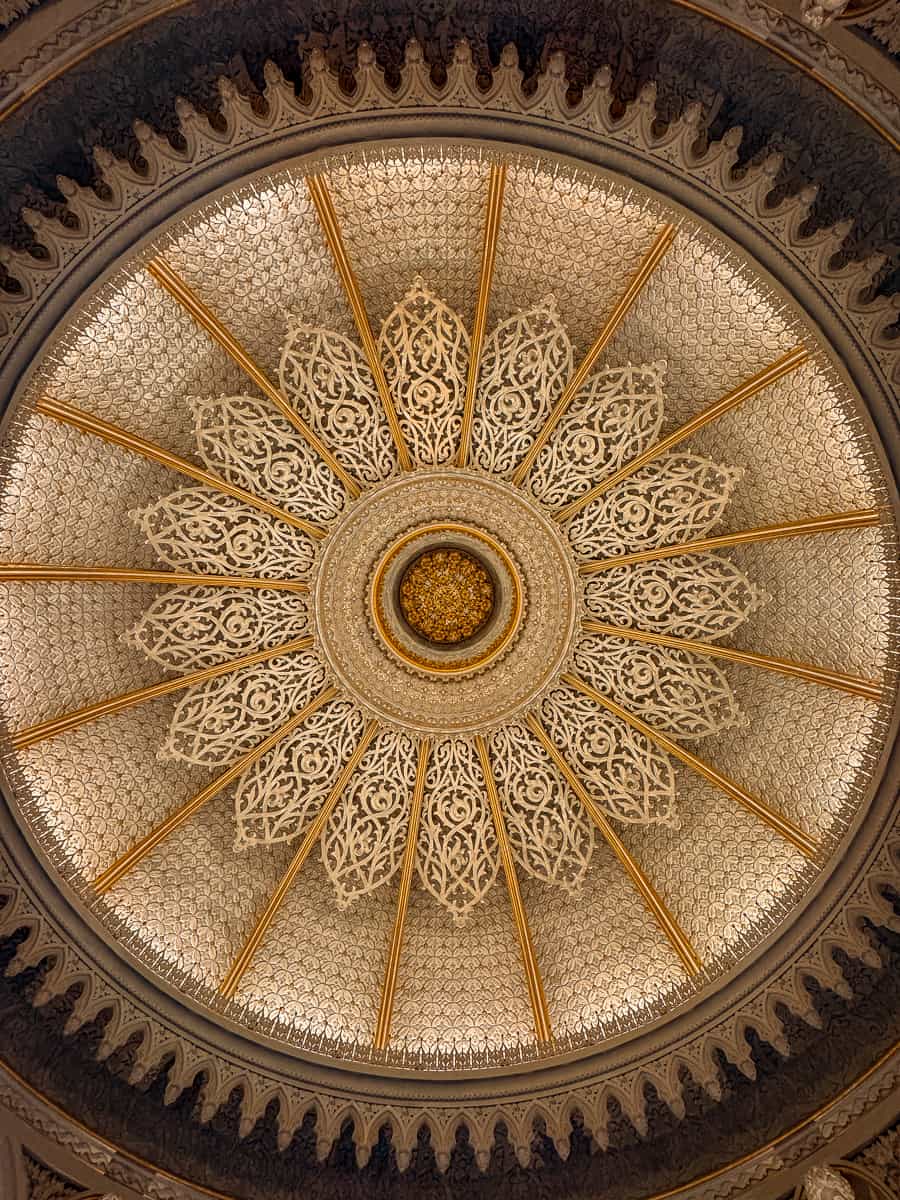
Sitting Room, Billiards Room & Dining Room
There are many other rooms you can explore in the house like the sitting room used by the Cook family.
Where the gentlemen would retire to the Billiard’s Room to smoke and play cards, the ladies retired here to have tea.
I found the dining room really impressive as it had gorgeous pink arches and stucco work on the walls and ceiling.
As there is no furniture, I loved the fact that the rooms have sound effects to set the scene. You’ll hear the family butler preparing tea and serving up a lamb dinner!
The meals were prepared in the kitchens under this floor and received upstairs with a serving lift that still works today.
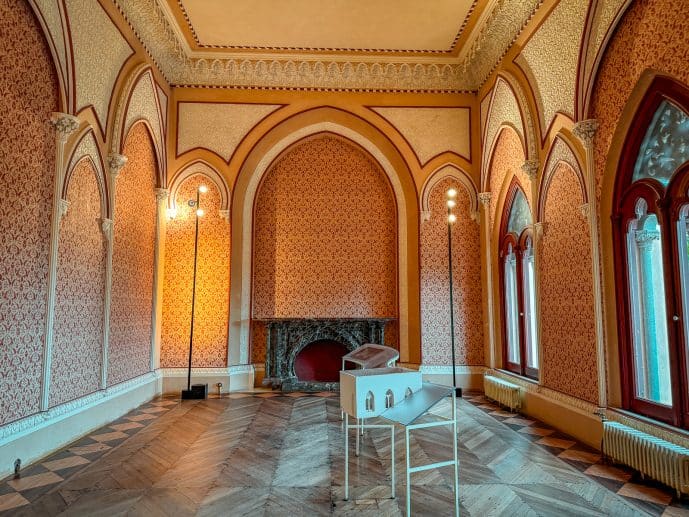
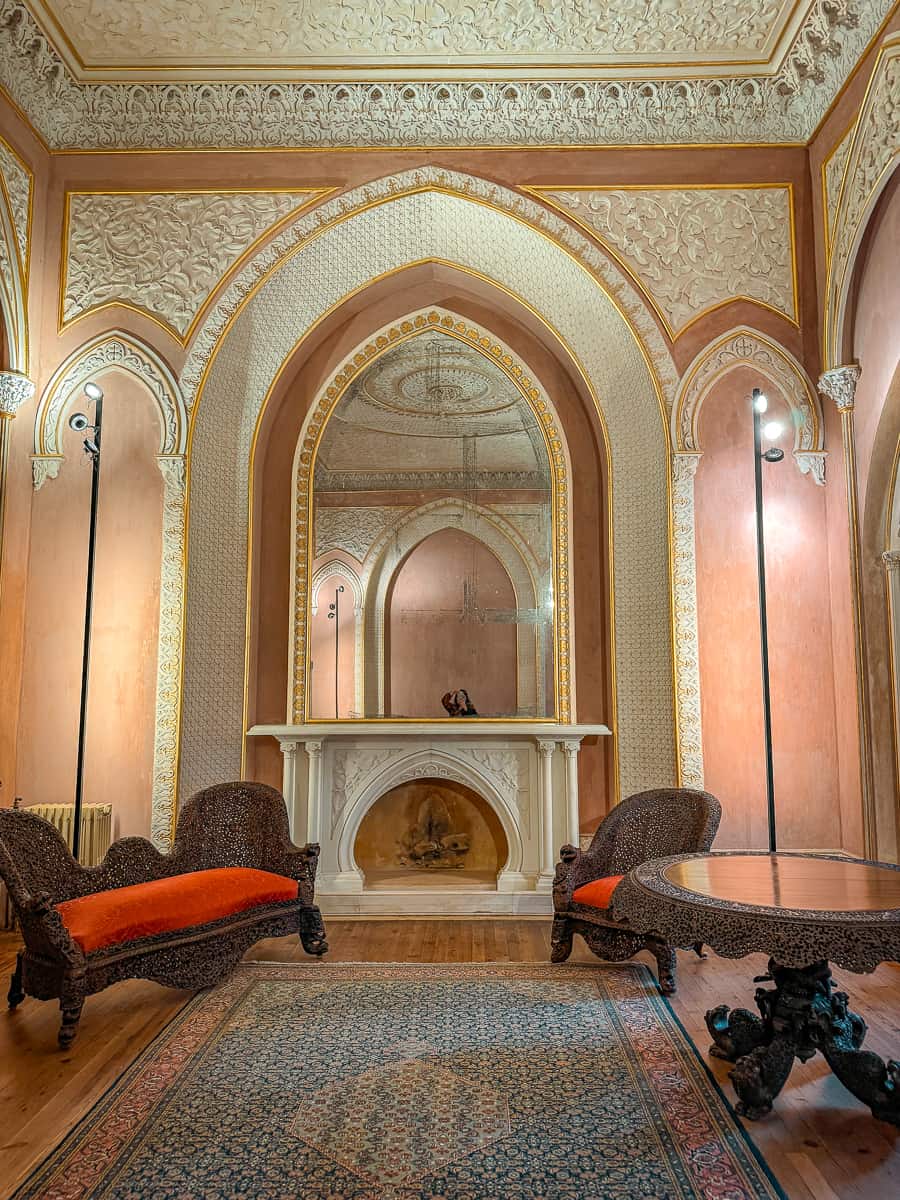
Upstairs exhibition
The upstairs is where the family bedrooms used to be but nowadays there is no furniture inside.
All of the rooms contain exhibitions and artefacts about the history of the house and the Cook family who owned it.
As the upstairs is located in a circular tower, all the rooms lead back to the ornate central hall and the mezzanine provides a beautiful look at the indoor fountain below.
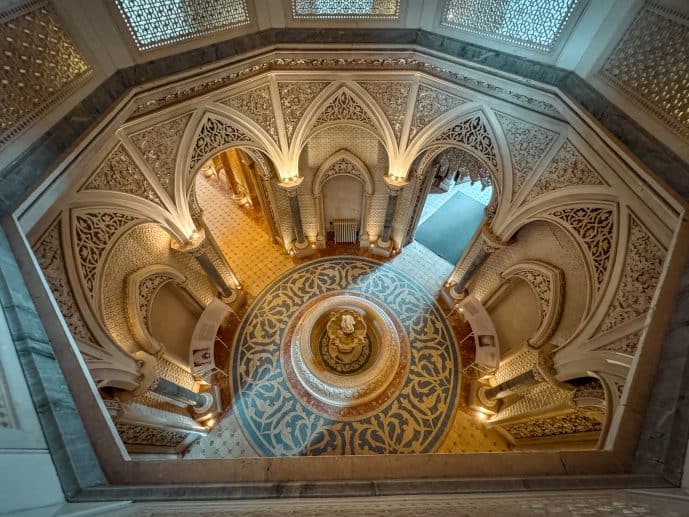
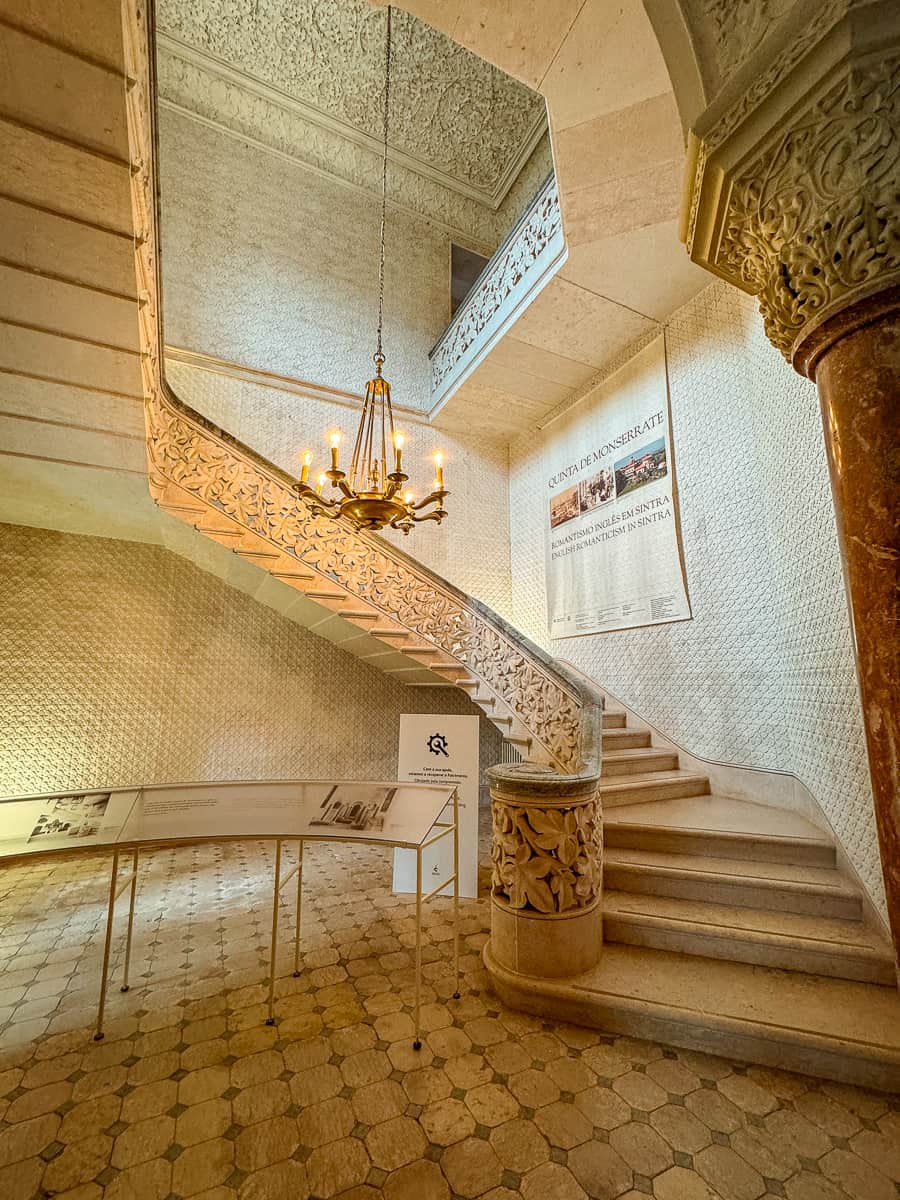
Arched Garden Entrance
My favourite part of the gardens was the arched terrace that could be found just outside of the palace.
This was used by the family as a terrace to relax and enjoy tea. It also provided a shortcut to the social rooms when entertaining guests.
This balcony was made with stunning carved archways and had panoramic views overlooking the Lawn and wider estate.
From here, you can descend into the gardens and explore all this parkland has to offer.
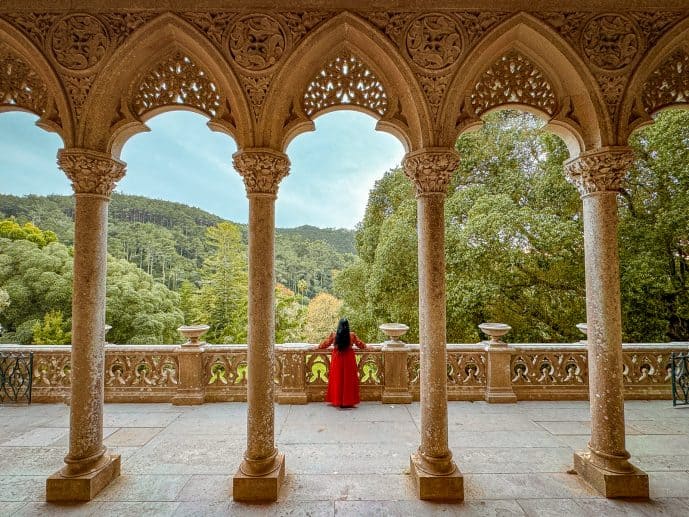
Ruínas da Capela de Monserrate & Gardens
Did you know that the Park and Palace of Monserrate have some false ruins that were installed?
They were designed by Sir Francis Cook and were created out of the former Chapel of Our Lady of Monserrate.
Many people think that this is Portugal’s Angkor Wat in Cambodia. You can definitely see the resemblance with the overgrown vines and tree roots taking hold of the foundations.
Unfortunately, this was closed off on my visit and I was pretty disappointed but it gives me a reason to go back!
After you can explore the Mexican Garden, Rose Garden, Lawn, Scented Path, Fern Valley and there’s even a farmyard.
Tea Room & Boulder House
After your visit, I would highly recommend relaxing in the crimson tearoom that’s located beyond the Indian Arch.
It has lots of seating indoors and outdoors depending on the weather and they do a great range of drinks.
The food in all the Sintra Palaces left much to be desired. But, they did have basic sandwiches and snacks if you’re keen.
I would recommend packing lunch if you didn’t want to spend money on overpriced tasteless meals.
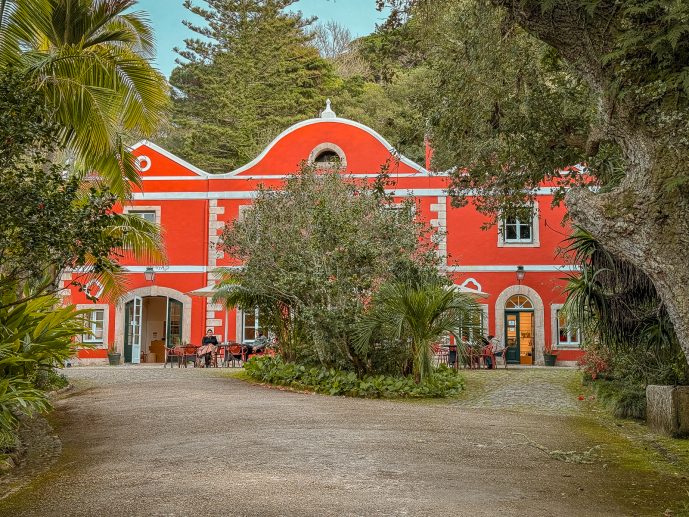
Just beside the tearoom, you’ll find a gift shop. I found most of the ‘official’ gift shops in the Sintra Palaces sold similar things which were mass-produced.
So, I would hold off souvenir shopping until the historic centre if you wanted a more unique artisan gift.
From the tearoom, you can access the toilets in the impressive Boulder House. This is used as the central office for the Administration of Sintra today.
Then, it’s just a short, steep walk back to the entrance to make your onward journey back to Sintra, Cascais or Lisbon.
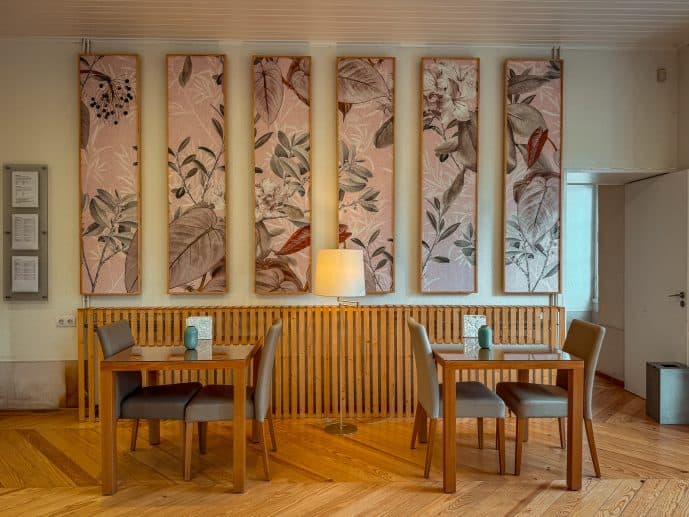
How to visit Monserrate Palace in Sintra
The Park and Palace of Monserrate can be found in Sintra which is a fairytale town built on rolling hills in Portugal that sees nearly 20 million visitors a year.
The estate is quite remote and further afield from other popular attractions like Pena Palace, the Moorish Castle and Quinta da Regaleira.
If you’re driving, it’s easy to travel here from Sintra Historic Centre and then use their large car park. But, if you’re relying on public transport to explore Sintra then some forward planning is necessary.
The bus lines 435 and 1253 do stop here but services stop in the early evening so make sure to plan your journey back.
I ended up taking an Uber there and back and it was simple enough but getting back was a little challenging.
Click here for a Google Pin to plan your journey
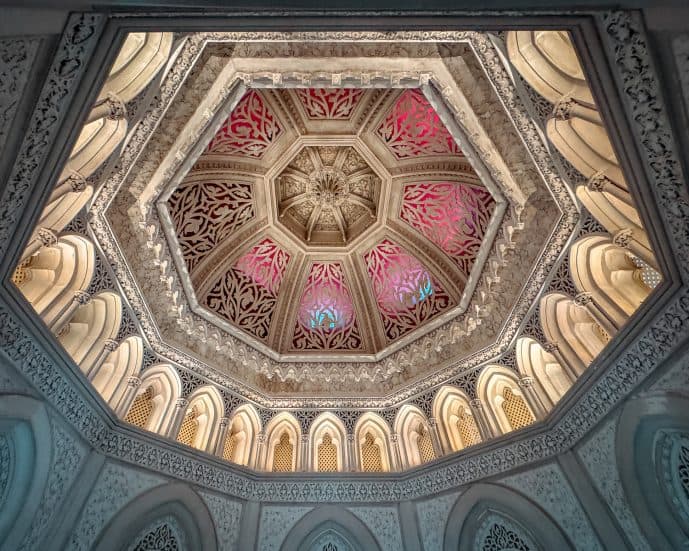
A note on taxis
Another option if you’re short on time is to take a Taxi or Uber and journeys are very affordable in Sintra.
I found getting to Monserrate Palace from Sintra easy enough. But, I didn’t count on the journey back being so complicated.
I left the park at closing time around 7 pm and, as it was March, it was very dark by then. Luckily, there were floodlights to light up the car park and bus stop but I was definitely a bit wary.
The estate is literally in the middle of nowhere in Sintra with the nearest village being around 4 miles away.
There were no buses as they had stopped running for the day. So, I tried to order an Uber to take me back but found it quite a challenge to get picked up.
The thing is, Monserrate is located on a rather lengthy one-way road system in the countryside and journeys from here to Sintra take a long time.
I started to panic as I genuinely thought no one would come but I did manage to get picked up in the end after around 30 minutes of trying and paying more for a faster pickup.
So, Uber is possible for Monserrate Palace just be prepared to wait a while! I’d also have the local taxi number on hand, Taxigal, as a plan B.
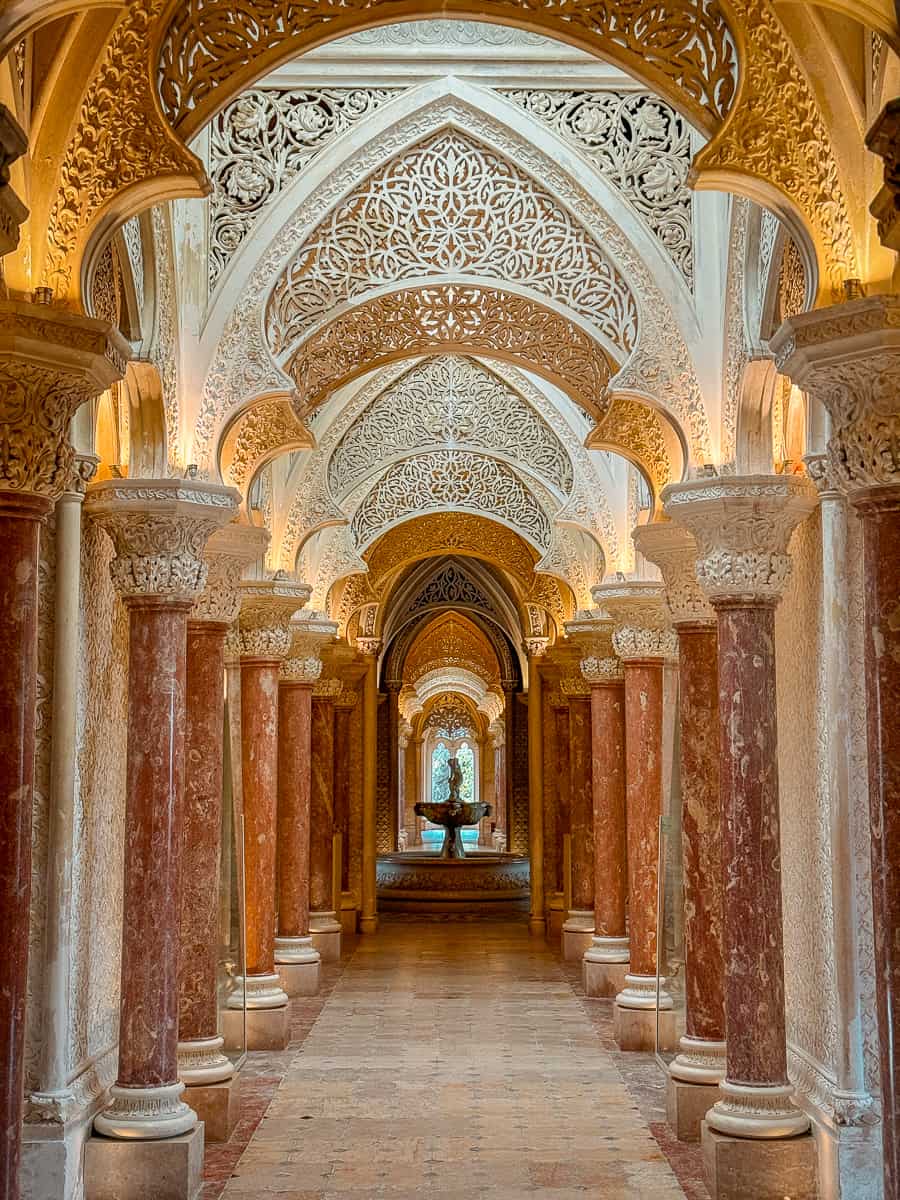
Opening hours and ticket prices
Monserrate Park is open daily from 9 am – 7 pm throughout the year. But, the last entry is around 6 pm for the gardens. It’s good to note that the palace closes at 6 pm so the last entry is at 5.30 pm.
Make sure to arrive at 5 pm latest if you’re hoping to explore the palace before it closes as it takes around 10-15 minutes to walk there from the entrance of the park.
I got here around 4.30 pm and found this was just enough time to see everything before it closed for the day.
Ticket prices are 12 euros for an adult and 10 euros for youths (6 – 17) and senior citizens. There are family discount tickets available.
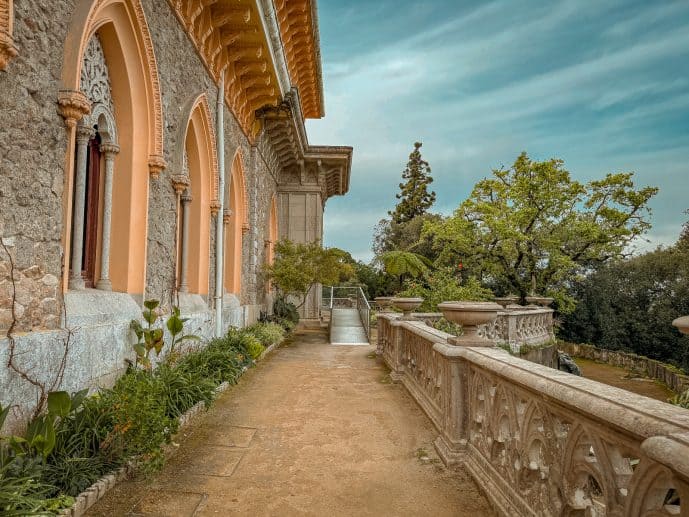
How long does it take to visit Monserrate Palace?
I would say you need around 2-3 hours to see everything at the Park and Palace of Monserrate at a relaxed pace.
The palace is relatively small with a few rooms but the gardens and parkland are extensive with lots of sections and notable features.
Add on a drink in the tearoom, a browse around the gift shop and the fact that there are lots of hills and steps on the estate, you’ll need a few hours at a minimum.
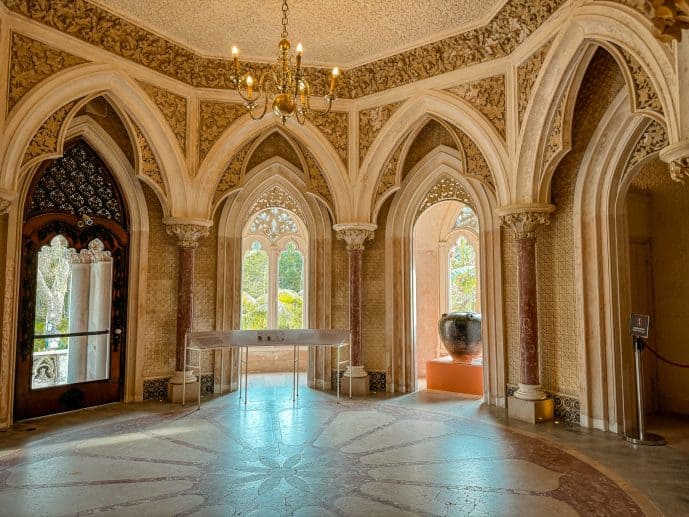
Is Monserrate Palace worth it?
100% YES! Looking back on my trip to Sintra, Monserrate Palace was one of my favourite attractions that I visited.
Although I preferred Pena Palace’s architecture, I relished that Monserrate had fewer crowds and it made my visit far more enjoyable.
As it’s a bit of a Sintra hidden gem, you can expect this parkland to be an oasis whatever the season. It’s filled with gorgeous attractions and the entire place felt utterly magical.
Don’t skip a visit to the Park and Palace of Monserrate in Sintra. It feels like a place thats been plucked from the page of a fairytale!
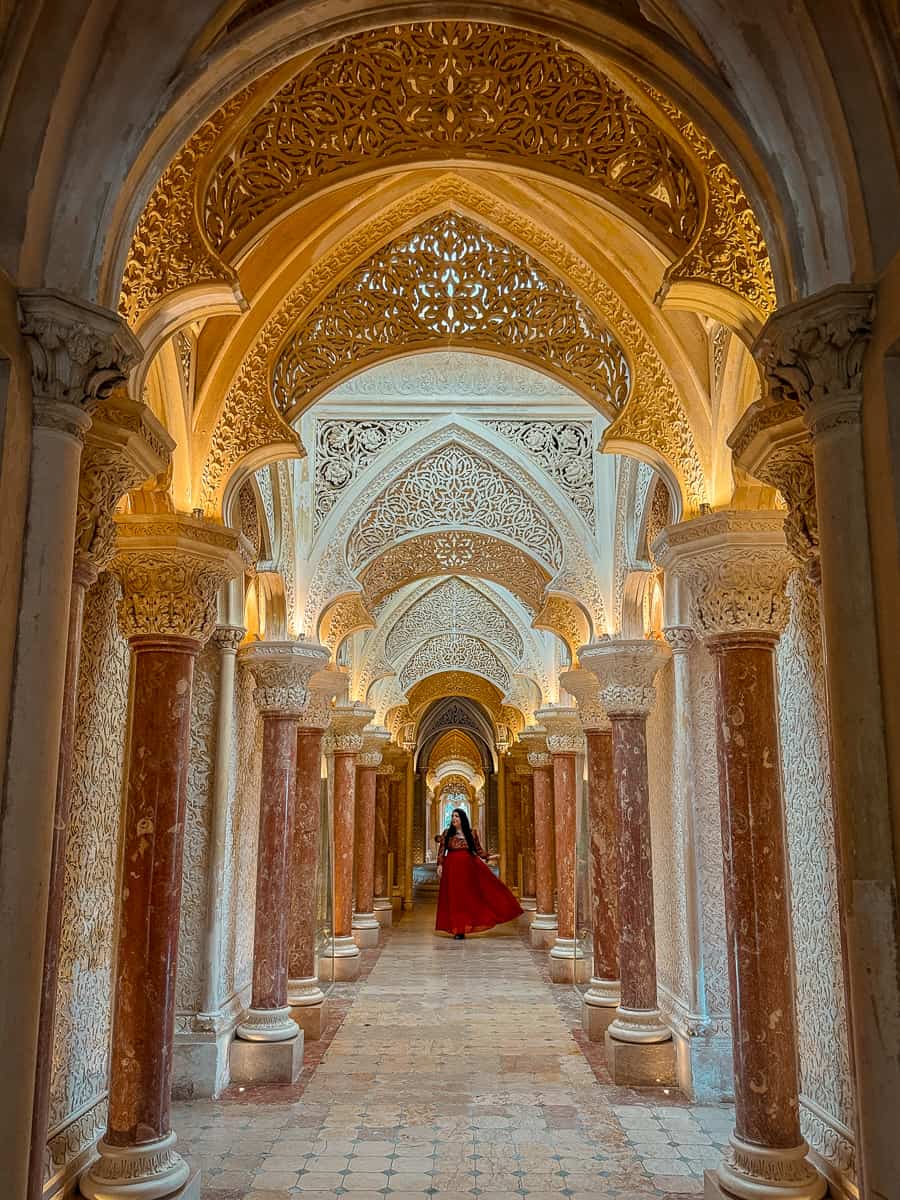
My top tips for visiting
- Visit early or late – although this palace is considered a ‘hidden gem’, it still sees quite a few visitors. It’s Sintra after all. It’s not a fraction of the Pena crowds but enough that I would say to come here earlier or later in the day for photography. I visited in the evening for closing time.
- Plan transport – Getting to Monserrate is easy enough with the bus line 435 but the last service back to Sintra is a while before the palace closes so check timetables. You can get taxis but Monserrate is located on a one-way road system and it can take quite a while to be picked up.
- Leave enough time – The Park and Palace of Monserrate are deceptively huge. The palace is rather small but the grounds are extensive. Leave at least 2-3 hours to explore everything.
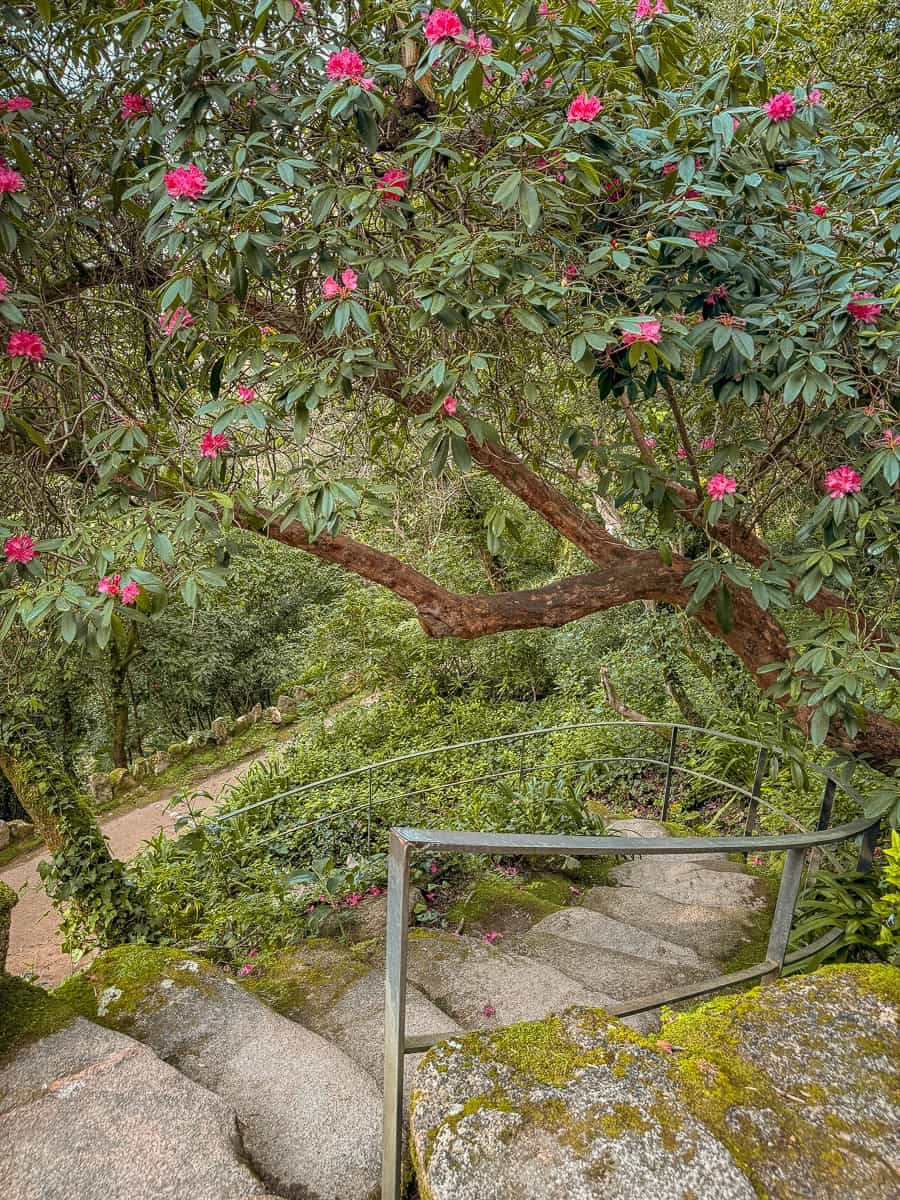
- Hills and steps – Like most Sintra attractions there are a lot of hills and steps to traverse in Monserrate so sensible footwear is recommended. There are accessible routes through the park but always check the access before you go. I found the route back to the entrance surprisingly steep!
- Bring water and snacks – there is a gorgeous tearoom in Monserrate I would recommend visiting but have water and snacks on hand as there’s lots of walking involved.
- Tripods – selfie sticks and tripods are not allowed inside the palace but using them on the park grounds is fine.
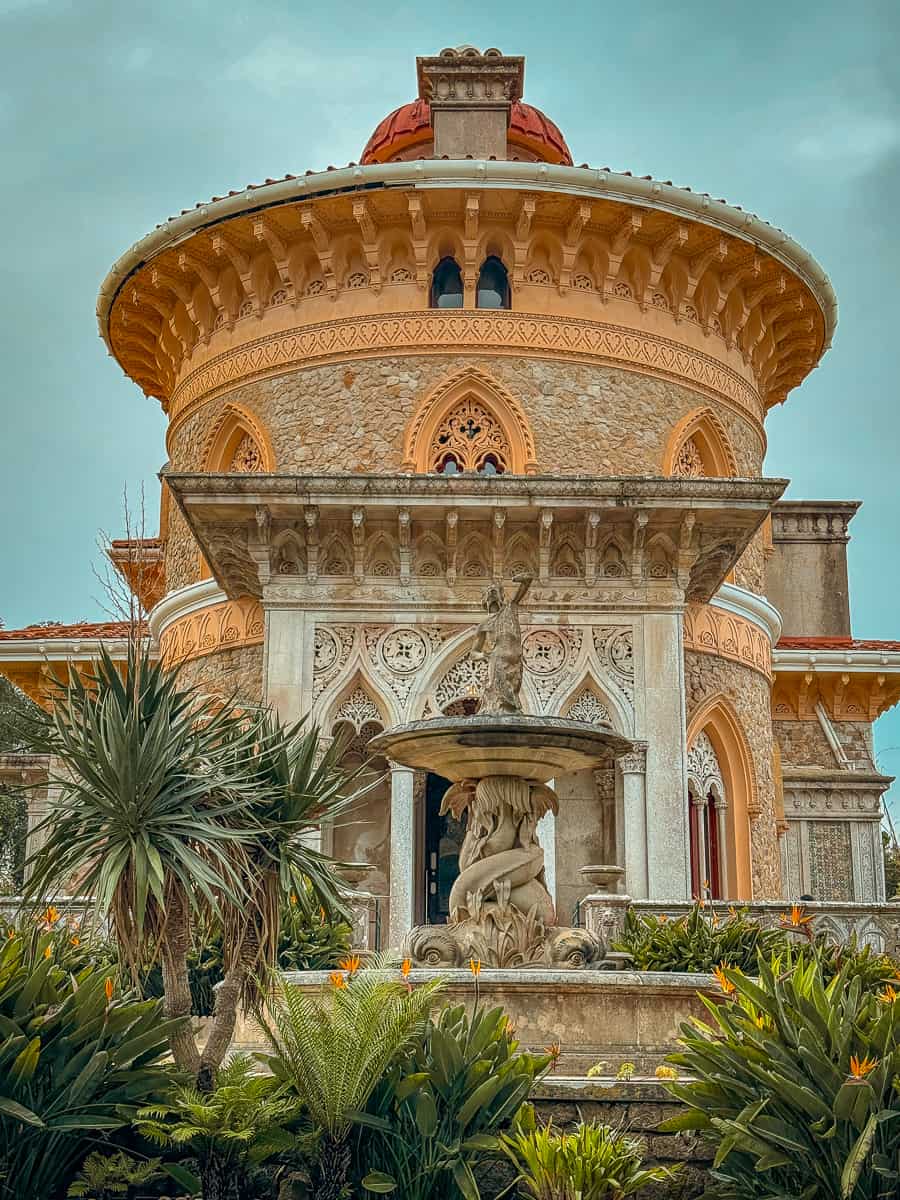
Looking for more magical places to visit in Sintra?
Sintra is one of the most magical places I’ve ever visited and the entire place will feel like you’re travelling through a fantasy land.
You’ll find all sorts of grand palaces, ornate gardens and dramatic castles built on rolling emerald hills with views of the Atlantic Ocean.
Although the most famous attraction is Pena Palace, there are so many magical things to do in Sintra. You could easily spend weeks here and not see everything.
Attractions are all based on steep hills and travelling to each one can be a challenge with public transport. So, I’d recommend at least 2 days in Sintra in order to see everything at a relaxed pace.
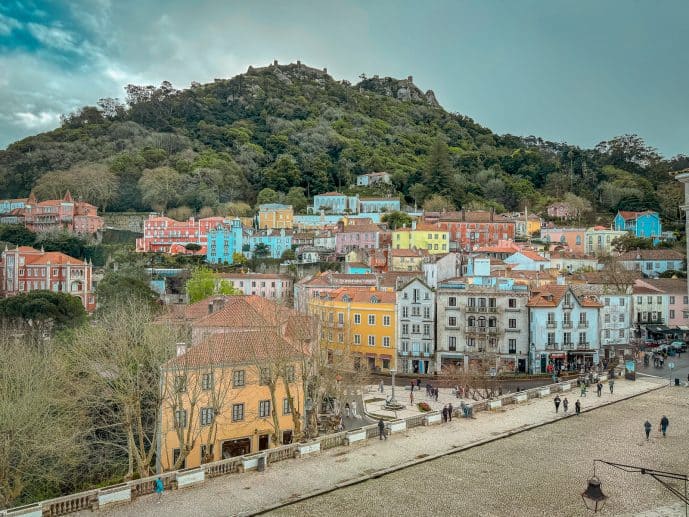
Pena Palace & Park
The main attraction of Sintra is hands down Pena Palace as it’s a beautiful romantic castle founded by Ferdinand of Saxe-Coburg and Gotha who married Queen Maria II.
It has a history since the 12th century as a monastery but was transformed into a dreamy palace with Ferdinand II’s personal fortune.
Today, this fairytale castle and surrounding gardens attract millions of tourists each year and it’s a must-visit.
Before you even plan your trip to Sintra, I would make sure your tickets are booked for Pena Palace as it’s not uncommon for tickets to sell out weeks in advance.
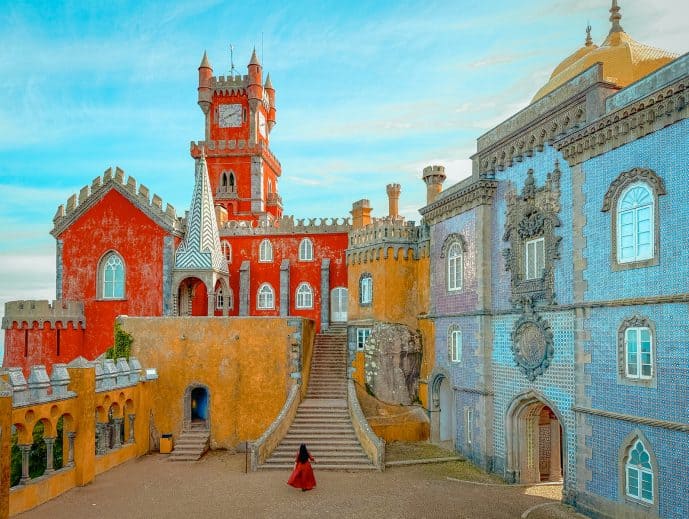
I’d recommend the first time slot of the day to avoid queueing for too long. Even on a weekday in March, the crowds were unbelievable.
Then, you need to plan how you’re going to get here as it’s located high on a hillside. There are buses from Sintra town but I’d recommend a taxi or Uber as the buses are usually full.
After you enter the park, the walk up to the palace can be quite steep but it’s manageable with a reasonable level of fitness.
After your palace visit, you can wander around the extensive Parque de Pena and see all its beautiful features like the Chalet of Countess Edla, greenhouses, stables, fountains and Valley of the Lakes!
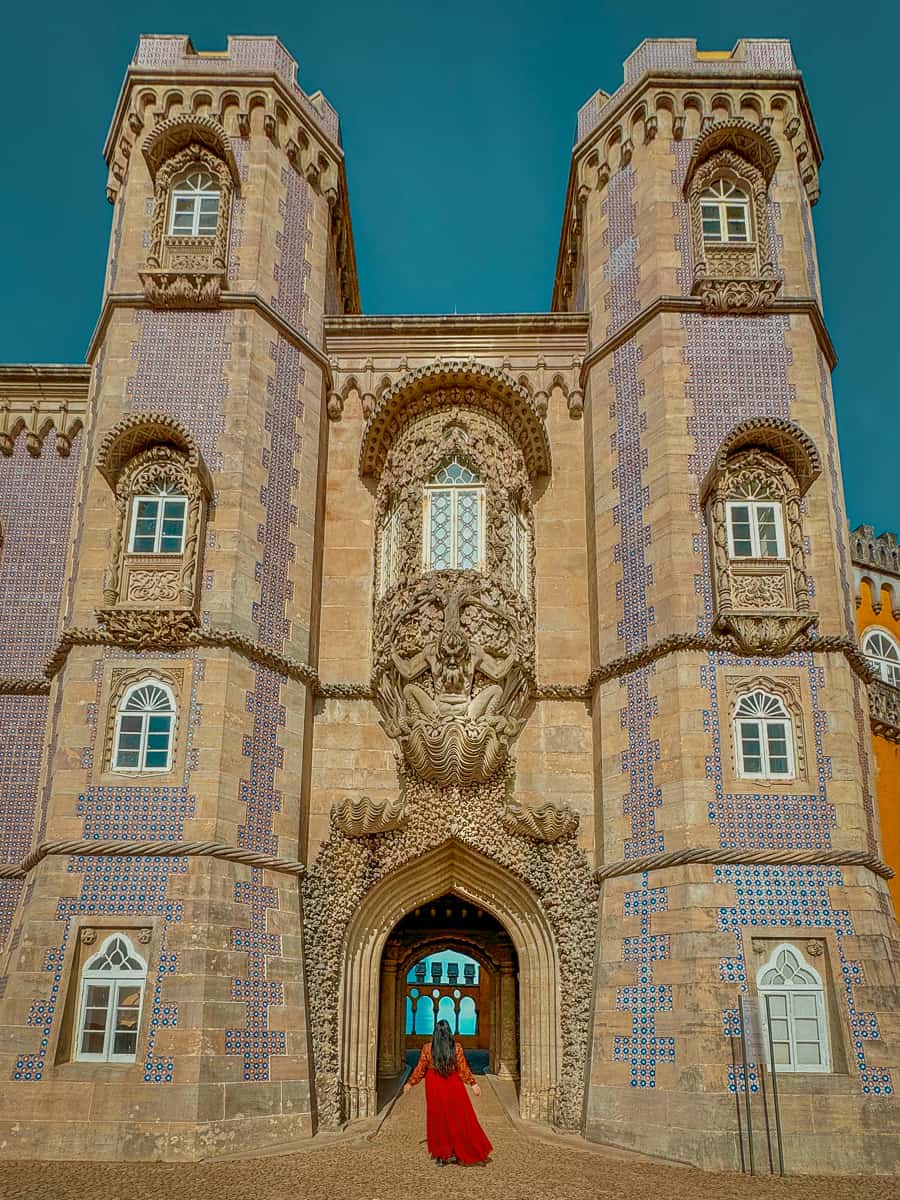
Moorish Castle
After your visit to Pena Park, it’s just a couple of minutes’ uphill walk to the Moorish Castle from the Valley of the Lakes.
The Moors lived in Sintra for centuries until 1147 and then the rule was handed over to Afonso Henriques, the first King of Portugal.
They left behind this gorgeous ruin built on the hillside and you can pay a visit to traverse the ancient walls with panoramic views over Sintra and Pena Palace!
I will warn you though, this is not a place to go if you’re afraid of heights or have bad balance.
As much as I loved exploring this castle, there were barely any safety barriers, lots of steep steps, uneven ground and narrow pathways.
I panicked a few times and had to take breather breaks as I was terrified, especially with the high winds and crowds. I had a white knuckle death grip on that crenelation! Just take your time and go slowly.
It may be worth purchasing tickets online before you go as there can be long queues for the ticket machines. There was only one working on my visit.
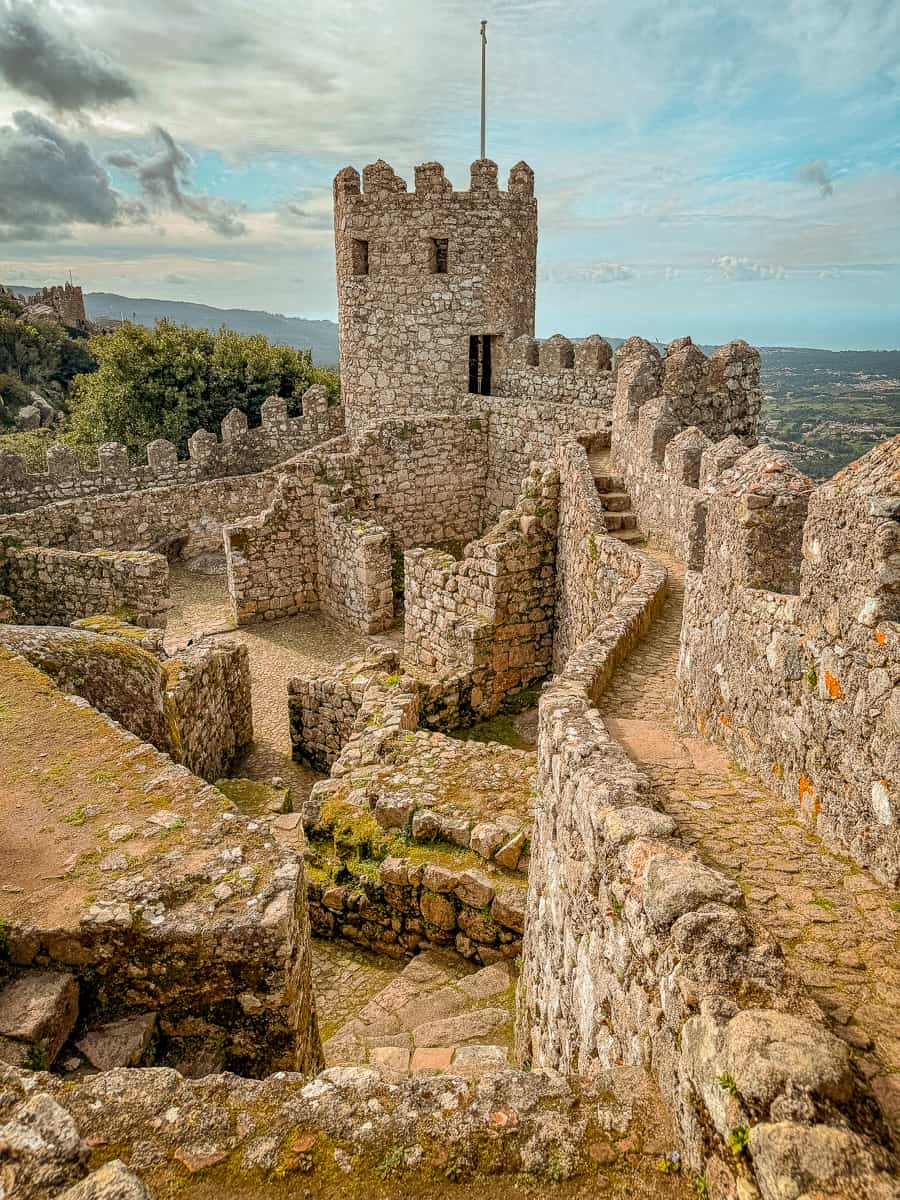
Quinta da Regaleira & Initiation Well
Quinta da Regaleira is an enchanting estate filled with magic and mystery. It was built by an eccentric freemason, António Augusto Carvalho Monteiro.
He bought the property from Baroness da Regaleira at a public auction in 1893. Monteiro would later create a gothic palace, chapel, Torre, celestial fountains and the mysterious Initiation Well.
According to legend, this land was home to the Knights Templar under King Alfonso Henriques.
The moss-covered Initiation Well is thought to have been used not for the collection of water but for Masonic initiations for the Knights Templar.
You could spend hours exploring this fairytale park and it’s not uncommon for there to be an hour’s queue to walk down the well in peak season.
I would visit the well around 30 minutes before closing time when there are fewer people and you’re not being cattle-prodded to keep walking down in a single file. When it’s busy, you’re not allowed to stop for photos.
I went around closing time and there was hardly anyone there. I got some lovely empty photos this way and it was a much better experience.
Click here to read my complete guide for the Initiation Well and tips for Quinta de Regaleira
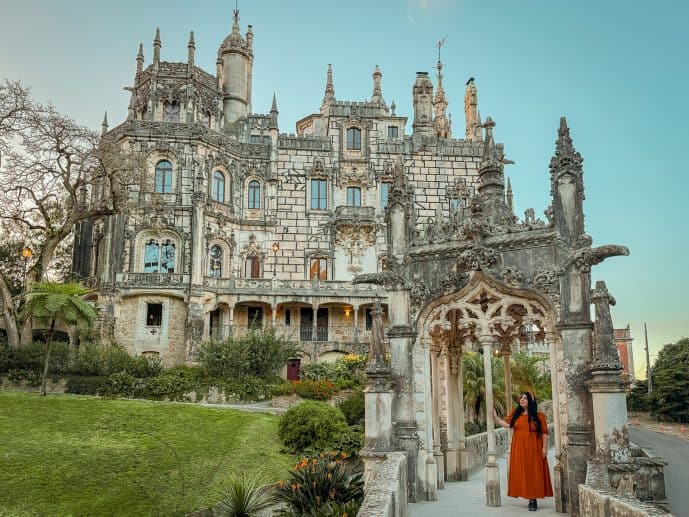
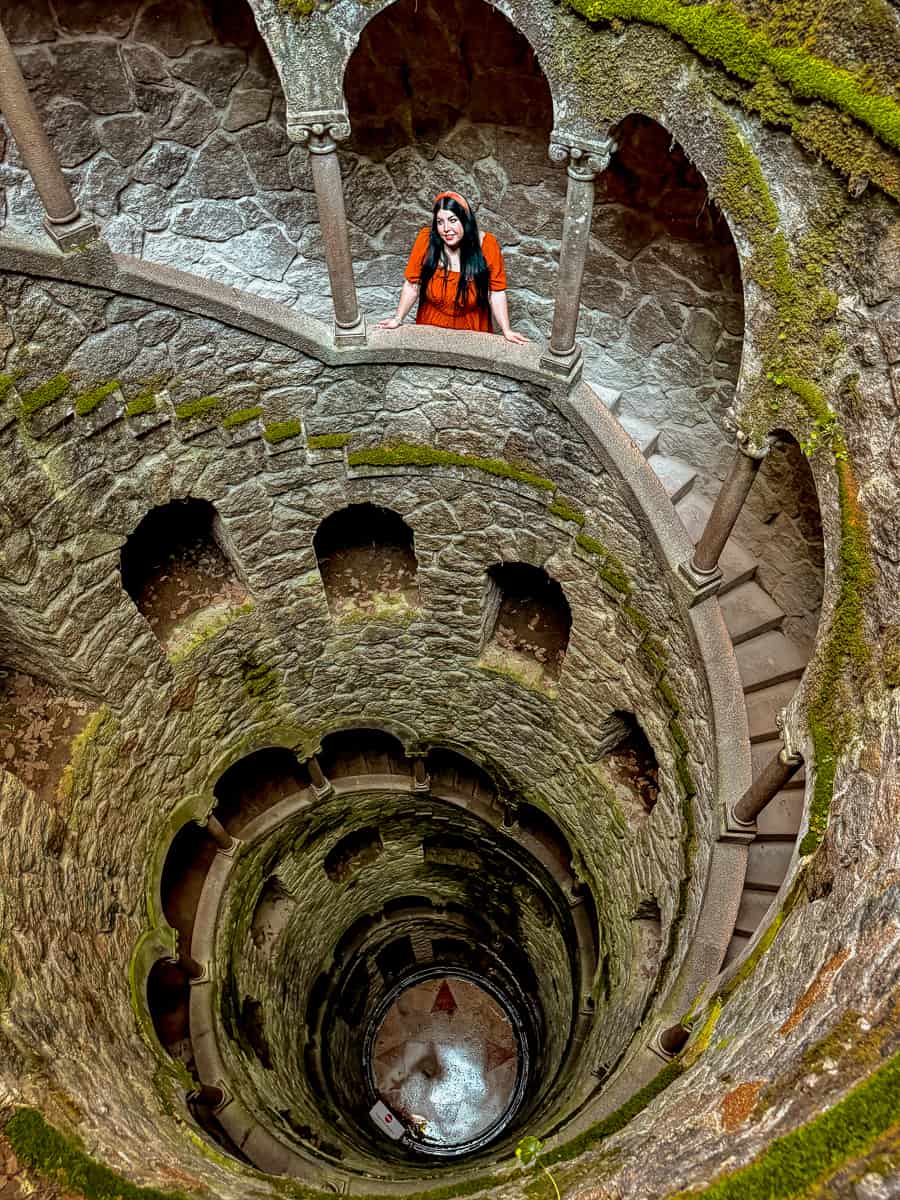
Sintra Historic Centre & National Palace
Most people only spend a day in Sintra from Lisbon and make a beeline to Pena Palace and the castles found around the area.
But, I wouldn’t skip a wander around the vibrant and colourful historic centre either. There are lots of shops, cafés, and museums to visit.
The Sintra National Palace sits in the centre and it’s a gorgeous museum filled with Azulejo tiled bedrooms, staterooms and kitchens. It was the home of King João I and Queen Philippa of Lancaster.
I particularly loved the Swan Room, Magpie Room and the spectacular Room of the Coats of Arms.
You can then pop into Casa Piriquita to try one of their famous Travesseiro pastries and a coffee!
If you’re looking for places to eat, I would recommend Metamorphoses and Incomum by Louis Santos by the train station. Or, Café Paris near the National Palace.
Sintra is known for its seafood as you’re so close to Cascais and the Atlantic Ocean. Octopus is usually found on the menu as the catch of the day.
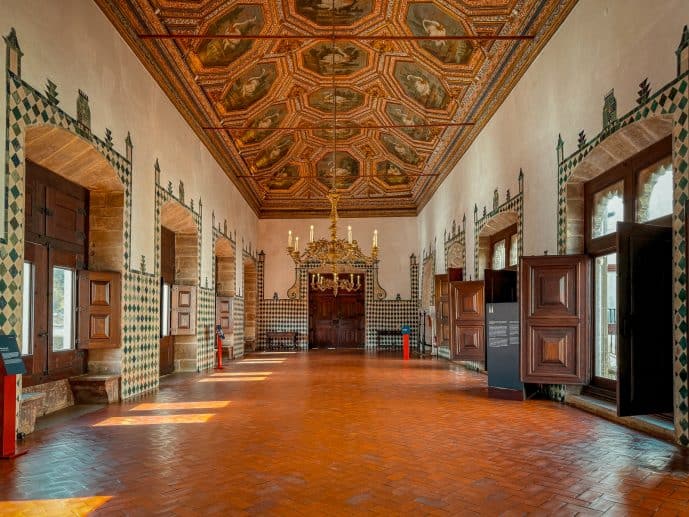
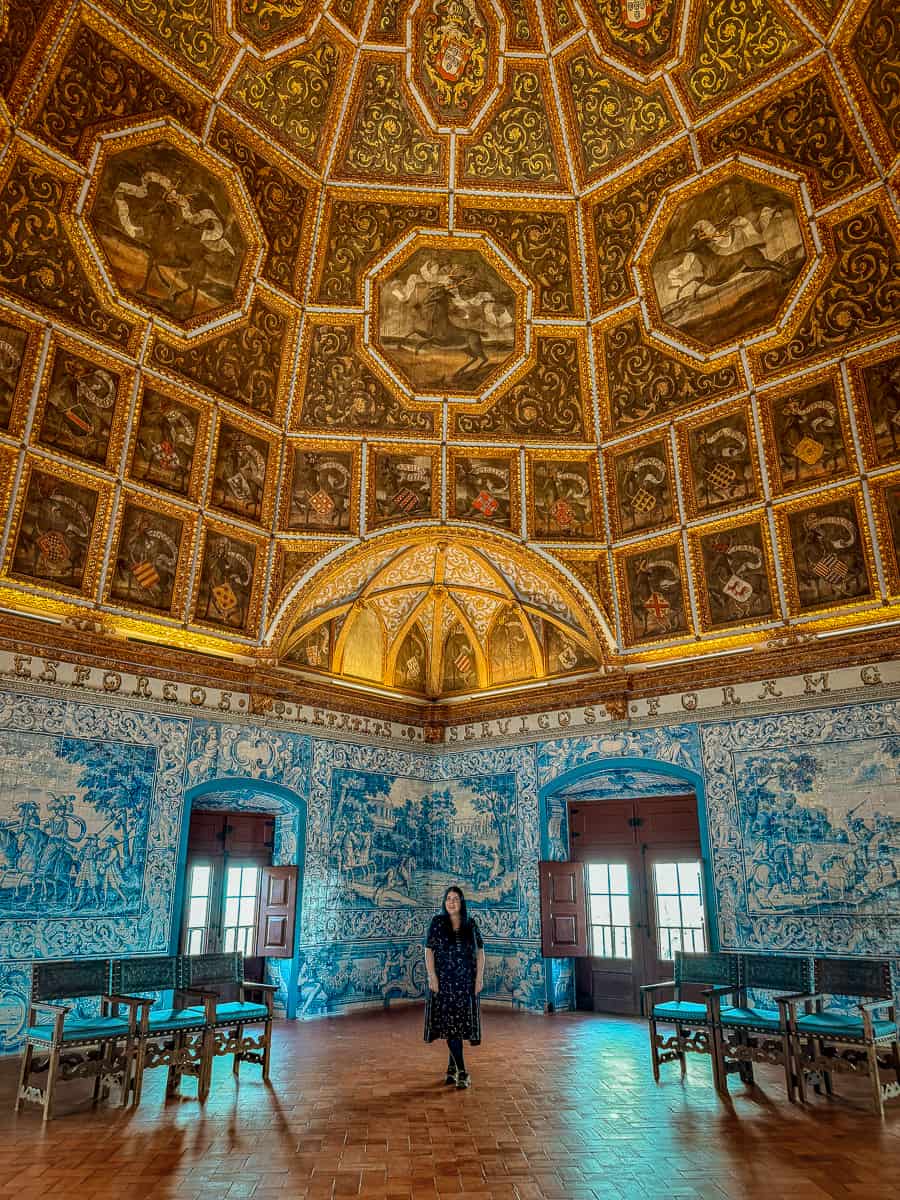
Where to stay in Sintra
If you’re looking for a truly beautiful place to stay in Sintra then I would recommend the Tivoli Palacio de Seteais.
It was a palace of the notable Marquis’ of Marialva who hosted Prince Regent John VI and Princess Carlota Joaquina here in 1802. They built a neoclassical arch in their honour.
Now, it’s a sumptuous 5-star property with rooms and suites overlooking the valley and coast of Cascais and you’ll be treated like royalty during your stay.
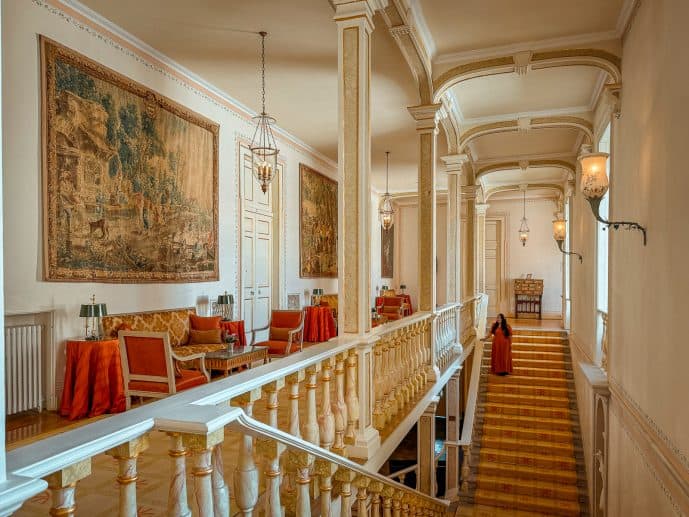
As a resort in Sintra, it also has a bar, restaurant, wellness suite and planned gardens to explore.
Even if you’re not a guest, I recommend paying a visit to the front courtyard as it has wonderful views through the arch. It’s just a few minutes walk from Quinta da Regaleira!
Click here to book your stay at Tivoli Palácio de Seteais
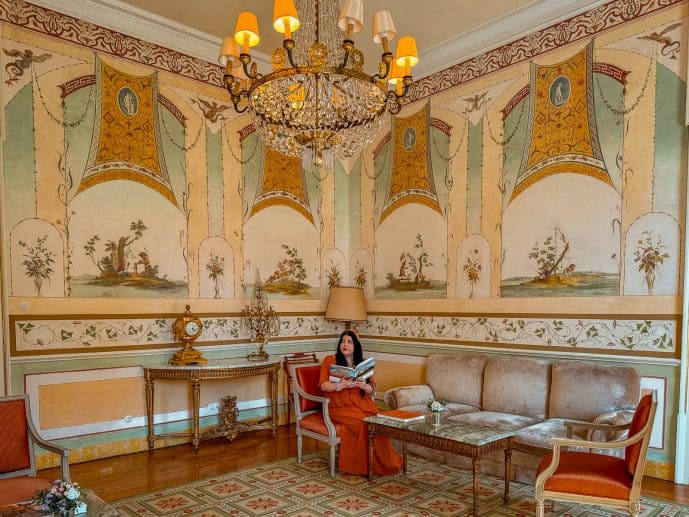
Read more of my Portugal travel guides
Palacio da Bolsa – How to visit Bolsa Palace in Porto
Livraria Bertrand – the oldest bookshop in the world
Why you must visit Café A Brasileira in Lisbon
Livraria Lello – magical bookshop in Porto
Was Harry Potter written in Porto’s Café Majestic?
Visiting the fairytale Palacio da Bolsa aka Bolsa Palace
Save Monserrate Palace Sintra for later!
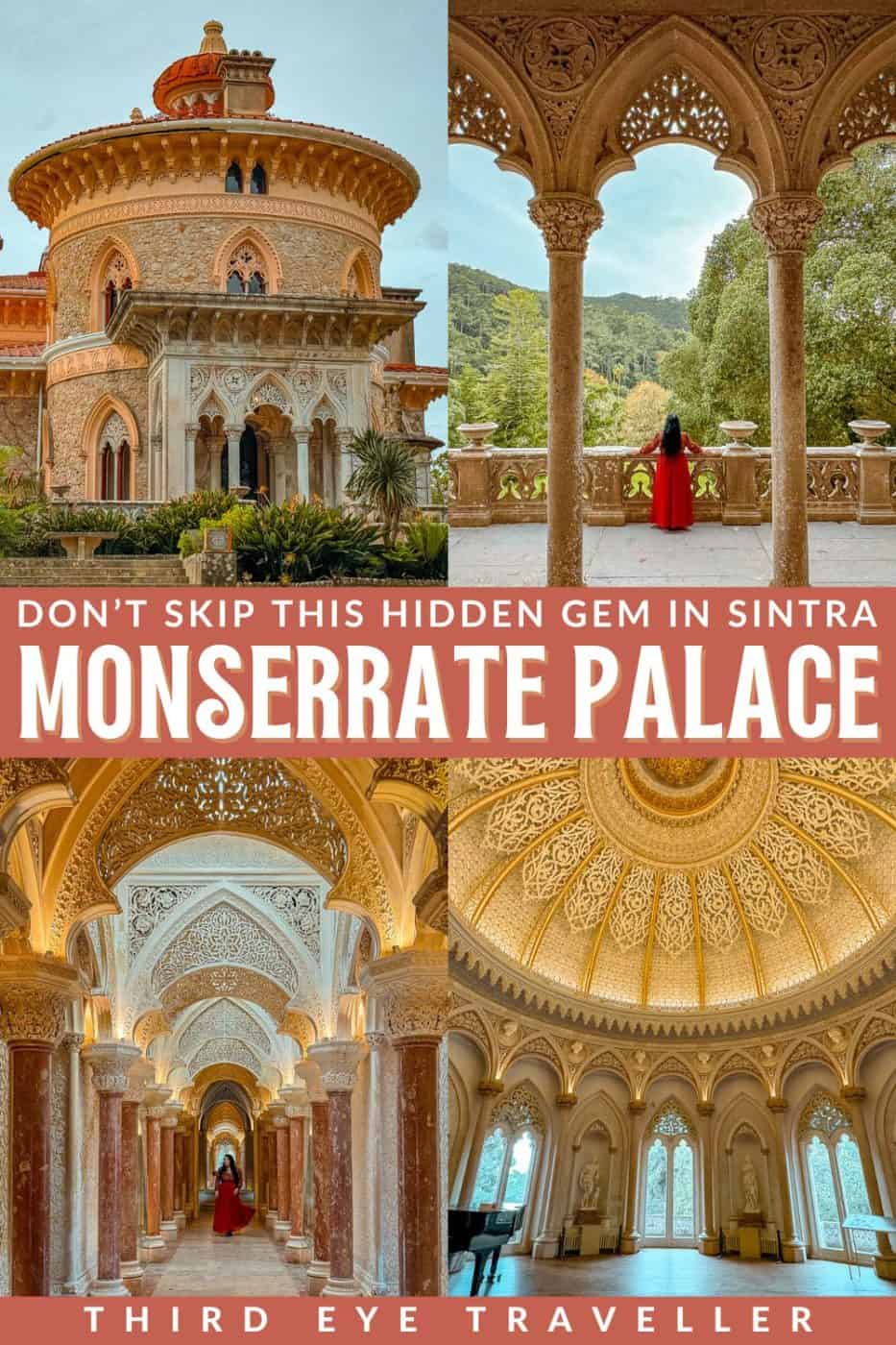
Here are some Portugal travel resources
- Flights: I use Skyscanner to look for flight deals. Try to be flexible with travel dates for the best prices.
- Accommodation: Booking.com is my go-to hotel platform and I’ve used them for years.
- Attractions & getting around: Make sure to buy a Lisbon Card for transport and attractions which will save you money.
- Car rental: Rental Cars is a great choice that compares all sorts of rental companies and gets you the best price.
- Activities: I love GetYourGuide and use the platform all the time for booking group tours and attraction tickets.
- e-Reader: I love to read Romantasy books and I always take my beloved Kindle Oasis with me. It has an orange light and is waterproof which is perfect for lounging by the pool.
- Travel insurance: I always use World Nomads to book travel insurance. You never know when you’ll need cover!
